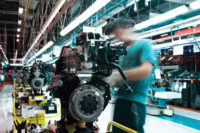While the economy has clearly improved, especially in the manufacturing sector, unemployment is still a problem and a drag on the overall recovery.
Also creating concern for recovery is the price of fuel and the sluggish housing industry.
With that said, there are certainly encouraging signs. In February, for example, employers added 227,000 jobs, featuring robust gains in manufacturing, healthcare and business services.
For the past several months job growth has averaged 245,000, about 100,000 more than the same period last year. That has pushed down the unemployment rate to 8.3 percent, the lowest in three years.
PPE sales increases
Manufacturers are a big source of job gains; they have added more than 100,000 jobs in the last three months, about one-third of all net gains. That strength is reflected in some of the sales increases we hear from many of our sources within the safety industry.
It is also reflected in our search activity as well as many other recruiters we speak with, both within the safety industry and other channels as well.
Also strong are U.S. service companies that stepped up hiring in March and continued to expand at a solid pace. The Institute for Supply Management reported on April 4 that its index of nonmanufacturing activity dropped to 56 in March, down from February’s 57.3, which was a 12-month high. Economists say the slight decline is not troubling because the reading is still at a healthy level that points to growth.
“The (ISM) survey still suggests that domestic demand is contributing more to the recovery,” says Paul Dales, an economist at Capital Economics. “This survey is still consistent with some decent rates of economic growth.” Sixteen of the 18 industries tracked by the survey reported growth. Greater spending “reflects the increased confidence level of businesses and consumers,” says Anthony Nieves, chairman of the ISM’s services committee.
Twisting, turning recovery
As we look at different states, the recovery takes many twists and turns, depending on the nature of their industries generally. For example, in California, unemployment fell to 10.9% recently, the first time in three years it has been under 11%.
By way of contrast, North Dakota enjoys a 3.1% unemployment, thanks in large part to oil drilling and exploration.
On the half-empty side of the ledger however, continuing declines in the construction sector worry economists. A recent report on construction spending showed that building activity declined for the second straight month. The report shows “that the economy is still locked on a very gradual healing trajectory,” said Steven Ricchiuto, chief economist for Mizuho Securities.
With back-to-back declines, construction spending stood at a seasonally adjusted annual rate of $808.9 billion, just 6.1% above a low hit in March 2011 and about one-third lower than the high hit during the housing boom.
Some cautionary signs in the ISM report, too. A measure of new orders fell but still showed growth. A gauge of sales and other business activity also declined.
On the campaign trail we will hear one side taking credit for any good signs in the economy and the other laying blame for any bad.
I’m pretty sure it doesn’t much matter what they say or do, when companies have confidence in the demand for their products or services, they will add the necessary employees to make and sell their products.
Dedication
I will dedicate this article to the memory of my mother, Margaret Niles, who passed away recently at 97 years and a life well-lived.
She had a connection to the safety industry in her role as the administrative assistant to the safety director of Kendall Refining Co. in Bradford, PA.


